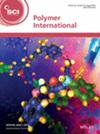Lohana Vieira Bataglini, Maria Luiza Paganini Maia, Bruna Louise Silva, Marlene Bampi, Luana Bettanin, Marcia Bär Schuster
下载PDF
{"title":"Toughening of thermoset matrix: effect of triblock copolymer addition and block sequence of PEG and PPG on phase morphology","authors":"Lohana Vieira Bataglini, Maria Luiza Paganini Maia, Bruna Louise Silva, Marlene Bampi, Luana Bettanin, Marcia Bär Schuster","doi":"10.1002/pi.70000","DOIUrl":null,"url":null,"abstract":"<p>In this study, an epoxy resin (diglycidyl ether of bisphenol A) was modified with triblock copolymers: poly(ethylene glycol)–poly(propylene glycol)–poly(ethylene glycol) (PEG-PPG-PEG) or PPG-PEG-PPG, with 10 wt% PEG in their structure, referred to as EPE and PEP, respectively. The aim was to evaluate the influence of the PEG and PPG block sequence on the phase morphology and enhance the fracture toughness of the thermoset matrix. Scanning electron microscopy revealed immiscibility for PEP systems and partially miscible to immiscible behavior for EPE systems, depending on the mass fraction used. The EPE fraction reduced the size of the dispersed phase, while the PPG end-group block sequence in PEP suppressed coalescence, stabilizing the dispersion and decreasing dispersed phase size. Differential scanning calorimetry showed a reduction of <i>ca</i> 20 °C in the glass transition temperature for the EPE systems, while for the PEP systems there were no significant changes, corroborating the immiscible system found in microscopy. Analysis of the mechanical properties revealed that incorporating the copolymer enhanced fracture energy absorption, as demonstrated by the increased toughness (up to 41%) compared to the neat epoxy. Systems with smaller spherical/ellipsoidal domains exhibited greater toughness, indicating that particle distribution and size significantly influence the material's toughness. Regarding tensile results, a reduction in tensile strength values was observed for all modified systems, especially for the EPE-10 system. These findings underscore the significance of the block sequence in triblock copolymers, emphasizing the importance of tailoring specific morphologies to enhance mechanical properties. © 2025 The Author(s). <i>Polymer International</i> published by John Wiley & Sons Ltd on behalf of Society of Chemical Industry.</p>","PeriodicalId":20404,"journal":{"name":"Polymer International","volume":"74 10","pages":"927-935"},"PeriodicalIF":3.6000,"publicationDate":"2025-06-26","publicationTypes":"Journal Article","fieldsOfStudy":null,"isOpenAccess":false,"openAccessPdf":"https://scijournals.onlinelibrary.wiley.com/doi/epdf/10.1002/pi.70000","citationCount":"0","resultStr":null,"platform":"Semanticscholar","paperid":null,"PeriodicalName":"Polymer International","FirstCategoryId":"92","ListUrlMain":"https://scijournals.onlinelibrary.wiley.com/doi/10.1002/pi.70000","RegionNum":4,"RegionCategory":"化学","ArticlePicture":[],"TitleCN":null,"AbstractTextCN":null,"PMCID":null,"EPubDate":"","PubModel":"","JCR":"Q2","JCRName":"POLYMER SCIENCE","Score":null,"Total":0}
引用次数: 0
引用
批量引用
Abstract
In this study, an epoxy resin (diglycidyl ether of bisphenol A) was modified with triblock copolymers: poly(ethylene glycol)–poly(propylene glycol)–poly(ethylene glycol) (PEG-PPG-PEG) or PPG-PEG-PPG, with 10 wt% PEG in their structure, referred to as EPE and PEP, respectively. The aim was to evaluate the influence of the PEG and PPG block sequence on the phase morphology and enhance the fracture toughness of the thermoset matrix. Scanning electron microscopy revealed immiscibility for PEP systems and partially miscible to immiscible behavior for EPE systems, depending on the mass fraction used. The EPE fraction reduced the size of the dispersed phase, while the PPG end-group block sequence in PEP suppressed coalescence, stabilizing the dispersion and decreasing dispersed phase size. Differential scanning calorimetry showed a reduction of ca 20 °C in the glass transition temperature for the EPE systems, while for the PEP systems there were no significant changes, corroborating the immiscible system found in microscopy. Analysis of the mechanical properties revealed that incorporating the copolymer enhanced fracture energy absorption, as demonstrated by the increased toughness (up to 41%) compared to the neat epoxy. Systems with smaller spherical/ellipsoidal domains exhibited greater toughness, indicating that particle distribution and size significantly influence the material's toughness. Regarding tensile results, a reduction in tensile strength values was observed for all modified systems, especially for the EPE-10 system. These findings underscore the significance of the block sequence in triblock copolymers, emphasizing the importance of tailoring specific morphologies to enhance mechanical properties. © 2025 The Author(s). Polymer International published by John Wiley & Sons Ltd on behalf of Society of Chemical Industry.
热固性基体的增韧:三嵌段共聚物加成及PEG和PPG嵌段顺序对相形貌的影响
本研究用三嵌段共聚物对环氧树脂(双酚A二缩水甘油酯醚)进行了改性:聚乙二醇-聚丙二醇-聚乙二醇(PEG- ppg -PEG)或PPG-PEG-PPG,其结构中含有10%的PEG,分别称为EPE和PEP。目的是评价PEG和PPG嵌段顺序对热固性基体相形态的影响,并提高其断裂韧性。扫描电子显微镜显示PEP体系为不混相,EPE体系为部分混相至不混相,这取决于所使用的质量分数。EPE组分降低了分散相的尺寸,而PEP中PPG端基片段序列抑制了聚并,稳定了分散相,减小了分散相的尺寸。差示扫描量热法显示,EPE体系的玻璃化转变温度降低了约20°C,而PEP体系没有明显变化,证实了显微镜下发现的不混相体系。力学性能分析表明,与纯环氧树脂相比,加入共聚物增强了断裂能吸收,韧性提高了41%。球/椭球域越小的体系韧性越大,表明颗粒分布和尺寸对材料韧性有显著影响。关于拉伸结果,所有改性体系的拉伸强度值都有所降低,尤其是EPE-10体系。这些发现强调了嵌段序列在三嵌段共聚物中的重要性,强调了定制特定形态以提高机械性能的重要性。©2025作者。《聚合物国际》由John Wiley &; Sons Ltd代表化学工业协会出版。
本文章由计算机程序翻译,如有差异,请以英文原文为准。




 求助内容:
求助内容: 应助结果提醒方式:
应助结果提醒方式:


